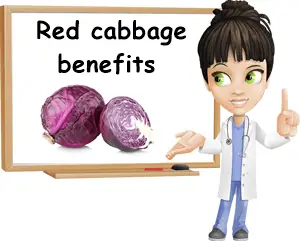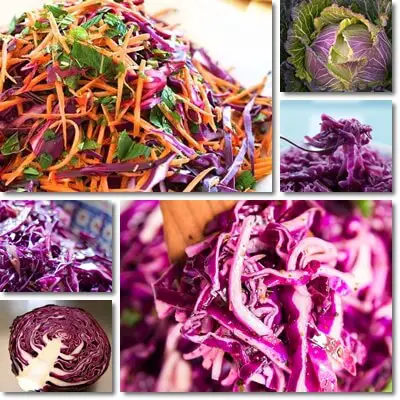Red cabbage is a colorful variant of the more common white or green cabbage. Scientifically it’s known as Brassica oleracea Capitata. It may be called either red or purple cabbage, the two names having to do with the fact that the vegetable typically occurs in two color variants: deep red and purple. Aside from the differences in color, red cabbage is nutritionally similar to the more common white or green cabbage varieties and holds roughly the same benefits and side effects.
What does red cabbage taste like? The raw cabbage has meaty, crisp leaves that almost pop when you bite into them and a firm stem that can become woody in older cabbages. The cooked vegetable softens considerably and can even become mushy if cooked for too long, but the stem tends to remain firm. Cooked red cabbage tastes sweet, with faint peppery notes. Raw red cabbage has a more prominent peppery aroma with a slight sweet aftertaste. It may also taste bitter to some people, but this has to do with individual taste perception.

What does red cabbage look like? Except for the color, red cabbage has the typical cabbage appearance: a heavy, bulky-looking head of large, tightly wrapped, deeply veined leaves that get looser and larger towards the exterior. The leaves of the raw cabbage are meaty and crisp, especially towards the base, but get soft and almost mushy when cooked. The stem can be fibrous or even woody in texture in larger, older cabbages and stays quite firm even when cooked, unless finely sliced or grated.
The color of red cabbage actually varies from a deep red to an almost bluish purple and sometimes red tinged with purple. The leaves are reddish or purplish on both sides, but creamy white on the inside, similar to the fibrous stem. During cooking, the pigments in the leaves leak into the cooking water and color the cabbage leaves entirely (red, purple or bluish). Depending on soil conditions, red cabbage varieties might not even turn out red or purple, but greenish with a yellow tint.
Where does red cabbage get its color from? Red cabbage gets its red, purple and even purple-blue and greenish-yellow colors from anthocyanins. Anthocyanins are naturally-occurring antioxidants and plant pigments. They are responsible for the entire range of red, purple and blue colors in plants. In greater concentrations, they generate really dark purple or blue colors that almost appear black, such as in blackberries, acai berries or aronia or chokeberry. The anthocyanins are pH-sensitive, meaning they can generate different colors according to pH.
Difference between red and purple cabbage. The color in red cabbage comes from pigmented anthocyanin antioxidants. Actually, the same anthocyanin pigment is the source of all the different colors in red cabbage: red, purple, bluish-purple and even greenish-yellow. The only difference between the red cabbages that are actually red and the red cabbages that are purple or another color is the pH of the soil they are grown in. An acidic soil (pH lower than 7) will produce reddish cabbages, a neutral soil (pH around 7) will produce purple cabbages whereas a basic or alkaline soil (pH higher than 7) will produce greenish-yellow cabbages. Cooked cabbage is purple-blue.

Frequently asked questions
Does red cabbage leave color? Owing to its rich content of pigmented anthocyanin antioxidants, red cabbage is known to stain skin temporarily and clothes permanently, especially lighter fabrics, which is why it’s best handled carefully in the kitchen.
Why does purple cabbage leave blue water when washed or cooked? Purple cabbage owes it purple color to being grown in soil with a relatively neutral pH – neither (too) acidic, nor (too) alkaline. As a result of the particular pH values of the soil, the anthocyanin pigments in the cabbage react by producing a purple color with more bluish pigments than red ones. When washed or soaked or cooked in water, purple cabbage is known to leave water blue. Red cabbage also leaves water purplish-blue. Adding specific amounts of lemon juice, vinegar or other acidic solutions can help maintain a more reddish coloration.
Red cabbage nutrition facts
See below the most notable nutrition facts of raw red cabbage per 100 g:
Vitamin A: 56 micrograms (mcg) from antioxidant carotenoids, or 16% of the recommended daily intake, RDI for an average adult
Pro-vitamin A carotenoid antioxidants: 670 micrograms (mcg) beta-carotene, 329 mcg lutein and zeaxanthin, 20 mcg lycopene
Vitamin B6: 0.209 mg out of the RDI of 1.3 mg, or roughly 6%
Vitamin B9 (folate): 18 mcg out of the RDI of 400 mcg, or roughly 4%
Vitamin C: 57 mg out of the RDI of 90 mg for men and 75 mg for women
Vitamin K: 38.2 mcg out of the RDI of 120 mcg for men (almost 30%) and 90 mcg for women (roughly over 40%)
Potassium: 243 mg out of the RDI of 4700 mg, or roughly 5%
There are also negligible amounts of vitamins B1, B2, B3, B5 and E, calcium, copper, iron, magnesium, phosphorus, sodium and zinc.
Macronutrients per 100 g of raw red cabbage:
Energy: 31 kilocalories (kcal)
Carbohydrates: 7.37 g of which 3.83 g are sugars and 2.1 g dietary fiber
Fats: 0.16 g
Protein: 1.43 g
Water content: almost 90.4 g
Nutrition facts for cooked red cabbage. By comparison, cooked red cabbage (boiled and drained) has only slightly more of some vitamins and minerals compared to raw red cabbage (negligible amounts though). The following differences in nutrition may be noticed: cooked red cabbage has less vitamin C (only 34.4 mg of vitamin C compared to 57 mg in the raw vegetable), 9.4 more micrograms of vitamin K as well as suffers an almost complete loss of pro-vitamin A antioxidants (from 56 mcg per 100 g in raw red cabbage to only 2 mcg in boiled red cabbage).
Pickled red cabbage nutrition. The nutrition of pickled red cabbage is expected to be similar to that of raw and cooked versions. There should be modest to good amounts of vitamins A, B6, B9, K and potassium, high amounts of sodium (salt is added to pickled vegetables to maximize shelf life) and negligible amounts of vitamins B1, B2, B3, B5 and E, calcium, copper, iron, magnesium, phosphorus and zinc. And another important aspect of pickled red cabbage nutrition: the brine or vinegar solution used to prevent spoilage also makes the cabbage an excellent prebiotic food, meaning it feeds good gut bacteria.
What are the benefits?
Red or purple cabbage benefits health as much as the green or white cultivars, irrespective if it’s eaten raw or cooked or pickled. For the most part, the health benefits of red cabbage are a result of its excellent antioxidant content, good nutritional value and prebiotic properties in the case of pickled red cabbage, and include:
1) Detoxifying action. Red cabbage contains organosulfur compounds, soluble fiber and other constituents that are known to promote and sustain detoxification via their action on digestive enzymes and digestive system activity. The detoxifying action is further owed to compounds that support and enhance liver function.
2) Anticancer properties. Naturally-occurring organosulfur compounds specific to red cabbage and related cruciferous vegetables (white and green cabbage, kale, cauliflower, broccoli, Brussels sprouts etc.) have been shown to possess antioxidant and anticancer properties in in vitro studies. Indole-3-carbinol is a sulfur compound in red cabbage known for its anti-estrogenic effects, with studies currently looking into its potential applications for breast cancer. Consumption of red or purple cabbage and related cruciferous vegetables is believed to have a protective anticancer action.
3) Relieves constipation. Red cabbage is a good source of (soluble) dietary fiber and regular consumption helps treat constipation. Dietary fiber in the vegetable contributes to regulating transit and promotes regular, easy bowel movements. A serving of 100 g of raw leaves provides 2.1 g of dietary fiber, whereas a serving of 100 g of boiled, drained leaves provides 2.6 g of dietary fiber.
4) Good for gut health. Pickled red cabbage is an excellent prebiotic food, meaning it helps feed good gut bacteria. Healthy populations of good gut bacteria contribute to the health of the digestive tract and even hold benefits for the immune system, both suppressing the growth of pathogenic bacteria and maintaining the health of the digestive tract lining.
5) Red cabbage for weight loss. With around 30 kcal per 100 g of raw and cooked red cabbage, the cruciferous vegetable is a staple in weight loss diets. With more than 2 g of dietary fiber per 100 g and over 90% water, it further helps regulate transit, impacts fat absorption, hydrates, satiates and contributes to maintaining a healthy weight.
6) Anti-aging and other benefits for skin. Red cabbage holds some benefits for skin health. First of all, it is rich in antioxidants which counteract cell damage from free radicals. Secondly, raw red cabbage is an important source of vitamin C which is vital for the production of collagen, the structural protein that maintains skin elasticity and a youthful appearance.
7) Other benefits. Eating red cabbage holds important benefits for women. The anti-estrogenic effects of various compounds in the vegetable, such as Indole-3-carbinol, may exert a protective effect against estrogen dominance and estrogen-driven breast cancer. The same compound and other constituents in the vegetable also hold anti-atherogenic properties, meaning they help prevent lipid plaques on the inside of artery walls that lead to the development of atherosclerosis and heart disease.
What are the side effects?
Red cabbage has both benefits and side effects. While the benefits grossly outweigh the side effects, it is important to be aware of the potential risks and contraindications of eating red cabbage, especially in excessive amounts.
1) Allergic reactions. It’s possible, although rare, to be allergic to cabbage. Avoid it in all forms and preparations if this is the case.
2) Sensitivity or intolerance. May manifest as loose stools or diarrhea and other symptoms of digestive upset. Eating even small amounts can trigger symptoms.
3) Digestive upset. A sore or upset stomach, abdominal bloating, gas or flatulence, excessive burping, stomach cramps, loose stools, diarrhea are common side effects of eating red and other types of cabbage.
4) Acid reflux and heartburn. Especially brought on by consumption of red/purple sauerkraut or pickled/fermented red or purple cabbage.
5) Affects blood clotting. Due to its relatively high vitamin K content which promotes blood coagulation. Side effects are associated with excessive consumption.
6) Medicine interactions. Eating red cabbage may affect how certain medicines are processed and either enhance or counteract their effects. Example: anticoagulants.
7) Side effects for the thyroid. Certain compounds in red cabbage can inhibit thyroid hormone production and accentuate symptoms of an underactive thyroid, possibly also encouraging goiter formation.
